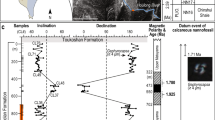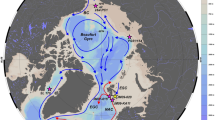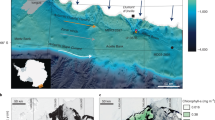Abstract
Circulation in the Pacific Ocean is periodically affected by El Niño events which are a direct response to intensity changes in trade winds1,2. The appearance of anomalously warm surface water in the eastern equatorial Pacific Ocean is one of the most spectacular manifestations of this event. Warm surface-water anomalies are also observed in the Northern Hemisphere along the Californian coast and in the Gulf of California. In the Gulf, strengthened trade winds induce upwelling during the winter, whereas in the summer, prevailing southerly winds provoke an input of warm water from the south3. We have sampled laminated sediments from the slopes of Guaymas Basin to reconstruct, with high resolution, variations of the hydrology of surface waters in the central part of the Gulf of California (sedimentation rate is of the order of 4 mm yr−1 at the top and 1–2 mm yr−1 down core). By analysing the oxygen isotope ratio of biogenic silica of diatoms4, we have recorded the surface-water temperature variations in the Guaymas Basin. The comparison of these fluctuations and variations of silicoflagellate abundance has allowed us to reconstruct changes in upwelling intensity during the past three thousand years. The present conditions of low upwelling activity are seen to be abnormal in comparison with those prevailing in the past.
This is a preview of subscription content, access via your institution
Access options
Subscribe to this journal
Receive 51 print issues and online access
$199.00 per year
only $3.90 per issue
Buy this article
- Purchase on Springer Link
- Instant access to full article PDF
Prices may be subject to local taxes which are calculated during checkout
Similar content being viewed by others
References
Cane, M. A. Science 222, 1189–1194 (1983).
Rasmusson, E. M. & Wallace, J. M. Science 222, 1195–1202 (1983).
Roden, G. I. Marine Geol. Gulf of California Mem. 3, (eds Van Andel, Tj. H. & Shor, G. G. Jr) 30–58 (1964).
Juillet-Leclerc, A. & Labeyrie, L. Earth planet. Sci. Lett. 84, 69–74 (1987).
Round, F. E. J. exp. mar. Biol. Ecol. 1, 76–97 (1967).
Zeitzschel, B. Mar. Biol. 3, 201–207 (1969).
Van Andel, Tj. H. Am. Ass. petrol. Geologist. Mem. 3, 216–310 (1964).
Juillet, A. thesis, Univ. Paris XI (1984).
Labeyrie, L. D. & Juillet, A. Geochim. cosmochim. Acta 46, 947–975 (1982).
Juillet-Leclerc, A. in Proc. 8th Symp. Living and Fossil Diatoms, 1984 (1986).
Shackleton, N. J., Imbrie, J. & Hall, M. A. Earth planet. Sci. Lett. 65, 233–244 (1983).
Quinn, W. H., Zoff, D. O., Short, K. S. & Kuo Yang, R. T. W. Fish Bull. 76, 663–678 (1978).
Enfield, D. B. & Allen, J. S. J. phys. Oceanogr. 10, 557–578 (1980).
Baumgartner, T., Ferreira-Batrina, V., Schrader, H. & Soutar, A. Mar. Geol. 64, 113–129 (1985).
Baumgartner, T. R. & Christensen, N. Jr J. mar. Res. 43, 825–848 (1985).
Badan-Dangon, A., Koblinsky, C. J. & Baumgartner, T. Oceanogr. Acta 8, 13–22 (1985).
Traganza, E. D., Silva, V. M., Austin, D. M., Hanson, W. L. & Bronsink, S. H. in Coastal Upwelling, Part A (eds Thiede, J. & Suess, E.) 61–83 (Plenum, New York, 1983).
Murray, D. & Schrader, H. Mar. Micropalaeont. 7, 517–539 (1982/1983).
Schrader, H., Pisias, N. & Cheng, G. Mar. Micropalaeont. 10, 207–233 (1986).
Allen, W. The Hancock Pacific Expeditions, Publ. 3, 37–59 (South California University, 1937).
Roden, G. I. Pac. Sci. 12(1), 21–45 (1958).
Wyrtki, K. J. phys. Oceanogr. 5, 572–584 (1975).
Rasmusson, E. M. & Carpenter, T. H. Mon. weath. Rev. 110, 354–384 (1982).
Philander, S. G. H. J. phys. Ocean. agr. 11, 176–189 (1981).
Dunbar, R. B. in Coastal Upwelling, Part B (eds Thiedel, J. & Suess, E.) 217–246 (Plenum, New York, 1983).
Soutar, A. & Isaacs, J. D. Fish Bull. 72, 257–273 (1974).
Heine, K. in Climatic Changes on a Yearly to millenial Basis (eds Morner, N. A. & Karlen, W.) 95–115 (Reidel, Dordrecht, 1984).
Oerlemans, J. Nature 320, 607–609 (1986).
Jones, P. D., Wigley, T. M. L. & Wright, P. B. Nature 322, 430–434 (1986).
Soutar, A. & Isaacs, J. D. Caif. Coop. Oceanic Fish Invest. Rep 13, 63–70 (1969).
Savitzki, A. A. & Golay, J. E. Analyt. Chem. 36, 1627–1639 (1964).
Author information
Authors and Affiliations
Rights and permissions
About this article
Cite this article
Juillet-Leclerc, A., Schrader, H. Variations of upwelling intensity recorded in varved sediment from the Gulf of California during the past 3,000 years. Nature 329, 146–149 (1987). https://doi.org/10.1038/329146a0
Received:
Accepted:
Issue Date:
DOI: https://doi.org/10.1038/329146a0
This article is cited by
-
Fisheries productivity in the northeastern Pacific Ocean over the past 2,200 years
Nature (2002)
-
Evidence from Cd/Ca ratios in foraminifera for greater upwelling off California 4,000 years ago
Nature (1992)
-
Biological production off Southern California is linked to climatic change
Climatic Change (1990)
Comments
By submitting a comment you agree to abide by our Terms and Community Guidelines. If you find something abusive or that does not comply with our terms or guidelines please flag it as inappropriate.



